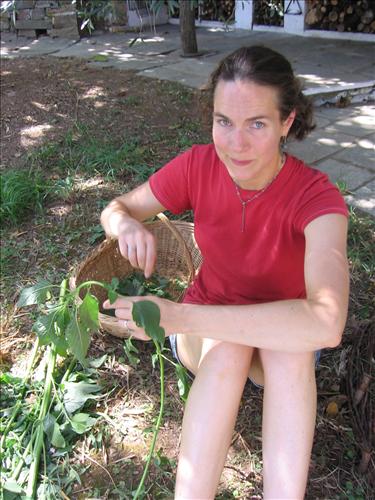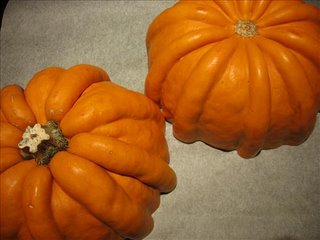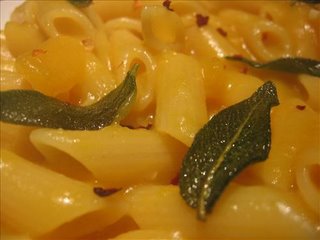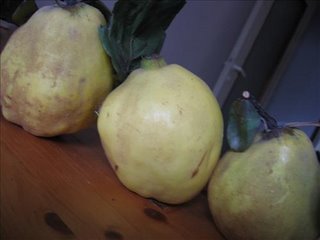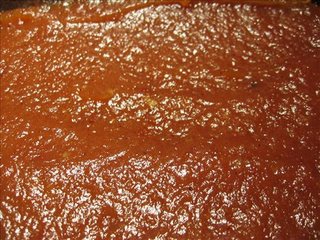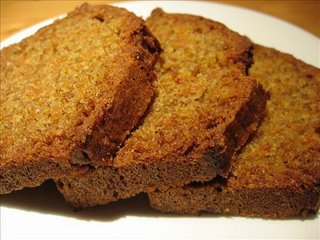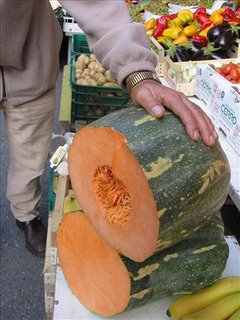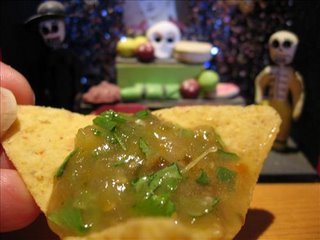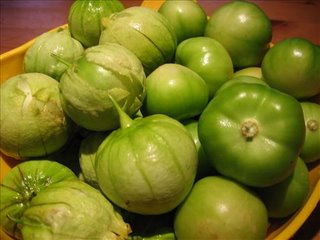
Last year I made my first pumpkin pie and it turned out surprisingly well since I followed a
recipe that promised zing but I found that, while it was good, it was still not zingy enough for me. This time I came up with a really spicy, gingery pie that will please all of you who think regular pumpkin pie is a bit thick and cloying. The 3 gingers in this pie are crystallized, fresh and ground. Here's my recipe:
Ingredients:
1-15 oz can of pumpkin puree
1/2 cup sugar
1/2 cup packed brown sugar
3 whole eggs
1 cup heavy cream
2 tbsps rum
2 tablespoons finely chopped crystallized ginger
1 tbsp fresh ginger, finely chopped almost reduced to a paste
1 tsp ground ginger
1 tsp ground true cinnamon (Mexican cinnamon)
1 tsp grated orange peel
1/4 tsp salt
1/2 recipe of
this great pie crust (or just make the whole thing and freeze half in a disk for later)
Pre-heat oven to 375F. Roll out the dough to just a bit bigger than your 9" pie tin, place in the tin and put the whole thing in the freezer.
Whisk pumpkin and the 2 sugars together to blend, add each egg one at a time until incorporated. Add all other ingredients (except crust of course) and mix to a uniform consistency. Pour into your crust (mine does really well without blind-baking, but I thing that's due to my pie tin. You do what you think is best.) and place on a rack at the bottom third of the oven. Bake for 1 hour until the center of the pie is set. If the crust is not browning well after 45 minutes, place at the top third of the oven and that should do the trick.
CANDIED CLEMENTINE PEELNow for a beautiful and zingy decoration for your pie, make Candied Clementine Peel.

First score the peel of 5 clementines (or mandarin oranges) with a serrated knife as you see here.

Then carefully separate the peel from the flesh with your fingers as so... (Or you can cut the clementines in half and juice them, then pull off the membranes and proceed from there.)

And finally take a cleaned pair of scissors and cut the peel along the rim with one hand while turning the peel with the other to make the longest slice of peel possible. By the time you get toward the center, you will have real curlicues and loopdy-loops which look great on the pie. Hint: Narrow strips of peel are NOT a goal here. Thicker strips not only remain more intact in the long, long boiling and simmering process but also serve for dramatic effect. This does make enough for snacking; I usually munch on the small, broken bits and save the long, culry things for the pie.
Fill a small saucepan with water and add the peel. Bring to a boil, and continue boiling uncovered for 10 minutes. Drain the water and repeat the boiling process with new water. This process helps to soften, sweeten and purify the peel.
Place 3/4 cups of sugar and 1 cup of water in another small saucepan. Bring to the boil and cook until the sugar dissolves. Add the drained peel to the sugar syrup and simmer uncovered for 1 hour.
Put the remaining 1/4 cup of sugar into a wide, shallow bowl. Once the peel has cooked for 1 hour, drain it and quickly roll it in the sugar. If you don't act quickly enough, the peel slices will stick to themselves. Arrange the longer pieces of peel into curly shapes. Remove the peel and set to dry on waxed paper.
*The left-over sugar syrup is wonderful as a sweetener for black tea!
THE BEST STUFFING EVER!
I followed
James Beard's Basic Bread Stuffing recipe. This recipe includes loads of suggestions of extras you can add. I took Mr. Beard up on the 1 cup of finely diced celery and 1 cup of toasred walnut halves then in the spirit of improvisation, and considering the fact that last years Porcini Cremini and Pancetta stuffing was a lot blander than it sounds, I added 4 ozs of hot Italian sausage (oh, I reduced the amount of butter called for by 4 tablespoons and kept all the fat from the sausage) and 1 oz of dried porcinis reconstituted in 2 cups of very hot water.
I followed the directions for combining the ingredients exactly then I browned the sausage, dumped it in then added the chopped porcinis, put the mixture into an oval baking dish and into the fridge it went (this was the day before our Thanksgiving). I strained the porcini soaking liquid to get the grit out and reserved that as well. Before baking the turkey, I poured half the porcini liquid onto the stuffing, and put it into a 400F oven. After 30 minutes, I took it out, stirred it around, added the other half of the porcini liquid and returned it to the oven for another 30 minutes. I PROMISE THIS WILL NOT DRY OUT! This can rest on your counter for a couple hours until you have taken out your turkey. While the turkey is resting and you're whisking up your gravy, stick the stuffing back into the oven and it will be warm enough to serve with everything else.
 At a big family party last weekend, my in-laws whipped up a huge buffet feast. One of the great things about French Swiss (and French French for that matter) formal dinners is the cheese course served after the main dish and before (or sometimes in place of) dessert. Here you see an array of Swiss cheeses. Notice the complete absence of holes here. You go from the rich, liquidy spreadableness of the Vacherin (at 12:00) to the solid richness of the Gruyere (at 3:00 and great for melting) to the oozy pungency of a very ripe Reblochon (at 5:00. Ok, so this isn't Swiss; it's from Haute Savoie which is so close to Geneva it's almost a suburb). And then ignore completely the rocky sharpness of the Parmesan (9:00) that we brought up from Italy for the occasion.
At a big family party last weekend, my in-laws whipped up a huge buffet feast. One of the great things about French Swiss (and French French for that matter) formal dinners is the cheese course served after the main dish and before (or sometimes in place of) dessert. Here you see an array of Swiss cheeses. Notice the complete absence of holes here. You go from the rich, liquidy spreadableness of the Vacherin (at 12:00) to the solid richness of the Gruyere (at 3:00 and great for melting) to the oozy pungency of a very ripe Reblochon (at 5:00. Ok, so this isn't Swiss; it's from Haute Savoie which is so close to Geneva it's almost a suburb). And then ignore completely the rocky sharpness of the Parmesan (9:00) that we brought up from Italy for the occasion.  A Swiss cheese that deserves it's own special plate and shaving device is the Tete de Moine (Monk's head) cheese that is eaten in paper-thin frilly curls. You might see the logic of the name since the top of the cheese is "bald" while the sides still have their covering.
A Swiss cheese that deserves it's own special plate and shaving device is the Tete de Moine (Monk's head) cheese that is eaten in paper-thin frilly curls. You might see the logic of the name since the top of the cheese is "bald" while the sides still have their covering. 